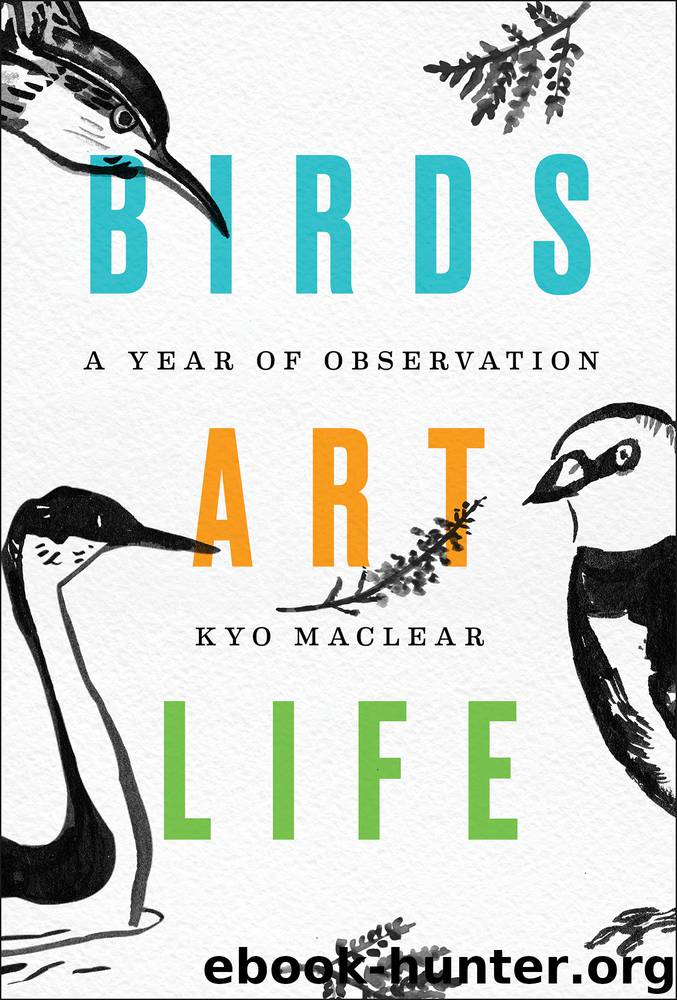Birds Art Life by Kyo Maclear

Author:Kyo Maclear
Language: eng
Format: epub
Publisher: Scribner
• • •
In May, one night, while thinking about falling I came across a funny and melancholy dance by Pina Bausch on YouTube. Early into the performance (1980—A Piece by Pina Bausch), a woman begins to skip around the stage in a large circle, waving a white handkerchief. “I am tir-ed, I am tir-ed,” she chants in a lilting rhythm while Brahms’s Lullaby plays in the background. Round and round she continues as real exhaustion catches up with her. Her chant grows halting, her steps clumsy. Her arm quakes with the effort of holding the handkerchief in the air.
Pina Bausch created this work soon after her longtime companion and closest collaborator, Rolf Borzik, died of leukemia.
Sometimes we falter not because the ground beneath our feet is unstable but because it’s exhausting to keep moving, to keep trying, to keep performing the same actions again and again.
• • •
Strong one moment, vulnerable the next, we falter because we are alive, and with any luck we recover.
• • •
Once I witnessed a windstorm so severe two 100-year-old trees were uprooted on the spot. The next day, walking among the wreckage, I found the friable nests of birds, completely intact and unharmed on the ground. That the featherweight survive the massive, that this reversal of fortune takes place among us—that is what haunts me. I don’t know what it means.
—Mary Ruefle, from Madness, Rack, and Honey: Collected Lectures
• • •
In May, waves of migrant birds were passing through the city’s ravines, parks, and backyards. One morning after breakfast my sons and I saw a delicate magnolia warbler in our lilac tree. We huddled by the balcony door and watched the tiny bird with its black-streaked yellow breast. I imagined it weighed as much as a Sharpie.
That bird had likely come from Central America, resting and refueling in Toronto on the way to its breeding grounds in northern Canada. It might have flown for sixty hours without stopping. I pictured it flapping its short wings and chirping, “I am tir-ed, I am tir-ed,” and all the other songbirds—the 50 million songbirds said to travel through Toronto during spring migration—all chiming in: “I am tir-ed, I am tir-ed.” We can learn something from the scrappiness of birds that come from as far away as the Argentine pampas and the Amazon jungle, from vanishing southern forest homes to equally threatened northern forests. I want to know how to be as undaunted as a migrating bird, how to sustain that perennial fortitude.
Night after night, an invisible songbird stream passed through the darkness. The birds came so close at times that we could hear their calls, occasionally audible through open windows.
• • •
A few days after seeing the magnolia warbler, I accompanied my father to a late-night MRI, a checkup to monitor his cerebral aneurysm. It was his first time back at the hospital since his prior “escape.” A brief visit, I promised. His balance was still off, a slight hesitancy shadowed his movements, but he was a bit steadier.
Download
This site does not store any files on its server. We only index and link to content provided by other sites. Please contact the content providers to delete copyright contents if any and email us, we'll remove relevant links or contents immediately.
| Erotica | Human Figure |
| Landscapes & Seascapes | Plants & Animals |
| Portraits | Religious |
| Science Fiction & Fantasy | Women in Art |
The Art of Boudoir Photography: How to Create Stunning Photographs of Women by Christa Meola(18537)
Red Sparrow by Jason Matthews(5390)
Harry Potter 02 & The Chamber Of Secrets (Illustrated) by J.K. Rowling(3622)
In a Sunburned Country by Bill Bryson(3486)
Drawing Cutting Edge Anatomy by Christopher Hart(3454)
Figure Drawing for Artists by Steve Huston(3384)
Harry Potter and the Prisoner of Azkaban (Book 3) by J. K. Rowling(3304)
The Daily Stoic by Holiday Ryan & Hanselman Stephen(3235)
Japanese Design by Patricia J. Graham(3110)
The Roots of Romanticism (Second Edition) by Berlin Isaiah Hardy Henry Gray John(2878)
Make Comics Like the Pros by Greg Pak(2852)
Stacked Decks by The Rotenberg Collection(2812)
Draw-A-Saurus by James Silvani(2656)
Harry Potter and the Deathly Hallows (7) by J.K. Rowling(2646)
Tattoo Art by Doralba Picerno(2600)
On Photography by Susan Sontag(2575)
Churchill by Paul Johnson(2506)
The Daily Stoic by Ryan Holiday & Stephen Hanselman(2461)
Drawing and Painting Birds by Tim Wootton(2438)
